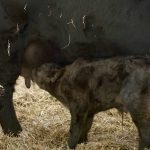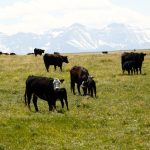Most beef producers know the frustration that accompanies dealing with the dreaded “dummy calf”. These calves will not suckle, won’t sit up or stand and stare blankly with what seems to be a lack of will and intelligence to survive despite your best efforts. This lack of coordinated movement is often due to respiratory acidosis. […] Read more

How to spot respiratory acidosis in a newborn calf

How to evaluate newborn calves using the calf VIGOR scoring system
Ideally, after a calf is born, things go well, and the cow and newborn calf thrive. However, it is important for producers to know how to assess calves for subtle signs of distress or trauma that can occur due to a difficult calving. Good vigor is a vital characteristic. A vigorous newborn calf has the best chance […] Read more

Making the most of available forage
Start the grazing season with a plan and lower cost of production over time
Developing a grazing plan is an important first step to ensure effective grazing management on an operation, and it can help save a producer on cost of production in the long run. A grazing plan that matches animal numbers to predicted forage yields should be made before turn out. Several key steps should be included: setting objectives […] Read more

One Health strategies help farm family navigate outbreak
The Haraga family calls in the troops to deal with a nasty zoonotic disease
This article was originally published at beefresearch.ca. It is reprinted here with the permission of the Beef Cattle Research Council. For Tyler and Nancy Haraga, March 10, 2018, will forever stand out in their minds. “It was forty below with four to five feet of snow,” says Tyler. It had been a brutal winter, with […] Read more

Forage U-Pick online tool now available Canada-wide
The Canadian farms producing top-quality beef are as unique as our country’s topography. They do have one thing in common–each uses forages in some way. Forage U-Pick–a tool that helps farmers and ranchers from British Columbia to the Maritimes choose forages best suited to their fields, calculate seeding rates and manage forage weeds–is now available […] Read more

VIDEO: How to intervene during a difficult calving
This article was originally posted to the Beef Cattle Research Council’s website and is republished here with permission. Calving cows out is a huge responsibility with many factors coming together to ensure a healthy calf hits the ground. A cow in ideal body condition, good breeding and genetics, and a clean environment are instrumental in […] Read more

Making money for the farm or from the farm?
Business Management: Ensure that you have a firm grasp of your numbers for better decision-making
This article was originally published by the Beef Cattle Research Council at beefresearch.ca. Are you making money FOR the farm or FROM the farm? If you are relying on off-farm income to cover the day-to-day expenses on the farm, you are subsidizing the farm with off-farm income — in other words, making money for the […] Read more

Grazing management terminology: Animal units, AUMs and how to apply them
Does it feel like grazing management information is shrouded in acronyms and terms that boggle the mind on first glance? Do you struggle to decipher terms like animal unit equivalents? And how does one go about calculating AUMs and then applying those numbers? Be reassured, you’re not alone! There’s a lot going on when sorting […] Read more

Bull Power: How to calculate the true value of a herd sire
Bull selection is a key decision for cow-calf producers that will have implications for both short- and long-term profitability. A bull represents half of your herd’s genetics and will sire calves to be marketed or represent the future of your breeding herd. With bull prices trending higher year after year, producers want to ensure that […] Read more

Calf 911: Managing colostrum so newborn calves thrive
Ensuring newborn calves consume colostrum is one of the most important management strategies cow-calf operations can implement to promote healthy calves. Colostrum provides essential antibodies (such as immunoglobulin G or IgG) to a calf with virtually no immune system. Colostrum also contains fats, vitamins, proteins and other immune cells essential to provide the calf energy, […] Read more


